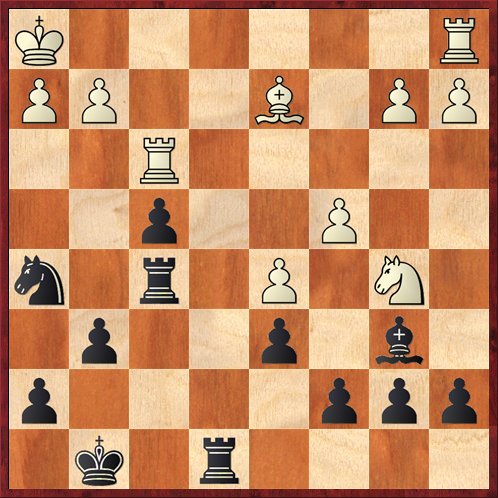I know my faithful readers want to hear more about my team’s victory at the US Amateur Team West this weekend. And of course you want games!
I don’t have any of my teammates’ games, but I can show you my game in the last round that gave us the necessary +1 score. (Our other three games were all draws.) This is one of those games that makes chess look ridiculously easy. All my pieces go to their perfect squares, and then a simple little piece sac forces mate. There’s almost nothing to analyze.
Here is the key position.
Black to play and win.
I know you can all solve this one in, like, ten seconds. Especially when you’re told “Black to play and win,” it’s clear what the winning move has to be.
But in tournament chess, funny things happen. My opponent has just traded queens and then played 22. c4. I think he relaxed after the queen trade, thinking that he could no longer be checkmated. Alas, after 22. … Ng3+! 23. Rxg3 (of course 23. hg Rh6+ is mate) fg, White has lost the exchange and he still can’t stop checkmate. After 24. Nc3 R8f8 White has a choice of being mated on f1 or on h5.
In fairness to my opponent, 22. c4 was not really that much of a blunder, because if he prevents the checkmate with something like 22. g3, he drops a piece because 22. … Rxd5 forks his knight and bishop. Ouch!
The crosstables for the tournament have now gone up at Bay Area Chess’s web page (http://bayareachess.com/events/12/usat.php), so you can look up how your favorite team did. As it turned out, Forfeit by Disconnection won by a clear point, with 5½ points. There was a four-way tie for second at 4½ points between Metropolitan Chess, Norcal House of Chess, ######, and the Hemet Chess Club. Metropolitan Chess took second place on tiebreaks. In fact, it’s interesting to note that the second through fourth place teams all had better tiebreaks than us, in spite of being a point behind! That’s because we had so many narrow victories.
Mike Splane, a frequent commenter on this blog, played on the second place team. They had a great comeback after an upset loss in round two knocked them out of contention. Their round-by-round scores were the exact opposite of ours, as they won by huge margins and lost by small margins: 4-0, 1½-2½, 3½-½, 2-2, 3½-½, and 2½-1½.
Amusingly, after 15 years of never being invited to play in the USATW, I was invited to play on two teams this year … Robin Cunningham’s team (which finished first) and Mike Splane’s team (which finished second)! I guess there was no way for me to go wrong, except perhaps by declining both.
Other random tidbits…
There were 4o teams overall.
Only one person went 6-0: Art Zhao, who played board four for the fourth-place team, ######. However, I think that Steven Gaffagan and I deserve some kind of recognition for scoring a joint 6-0 on our fourth board!
Not only that, our team prevented two other people from going 6-0, and they were both hugely important games. In round five Julian Chan pulled out a remarkable draw save against Ron Cusi, which was the only blemish on Cusi’s otherwise perfect 5½-½ record. And in round six Todd Rumph saved an exchange-down ending against John Langreck, who had gone into the round with a 5-0 record.
And meanwhile, Todd Rumph reports that the following teams won the other three sections:
East (always the biggest region — this year they had 294 teams!): Forking with Tebow’s Knights, 5½-½.
North (39 teams): Chess X-Men, 5-0.
South (40 teams): Yo Doy Clase, 4½-½.
All four regions had a clear winner — there were no tiebreaks required.




{ 1 comment… read it below or add one }
Congratulations!
How about a photo of the trophy for the fans – or better yet, THE TEAM 🙂